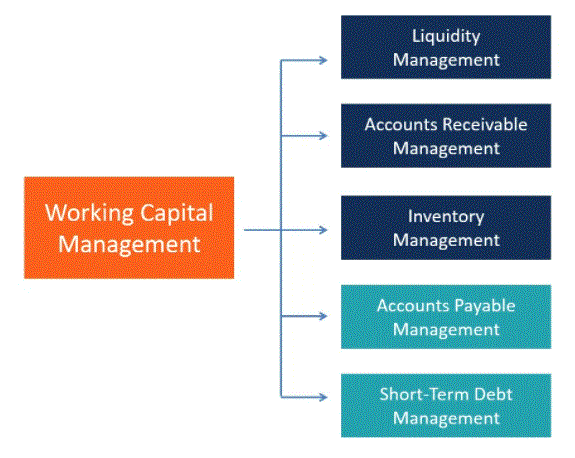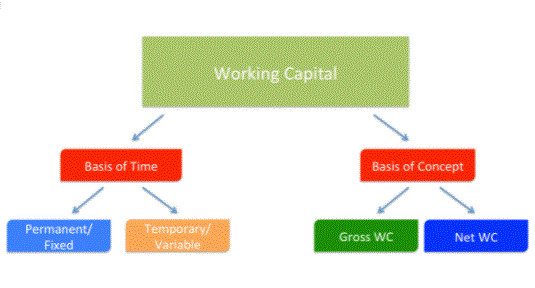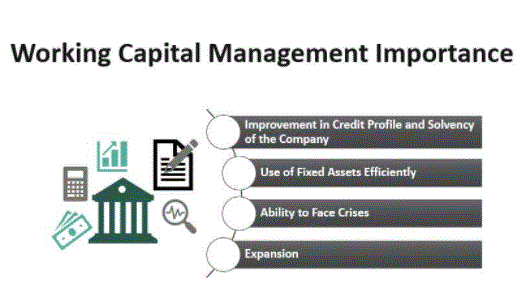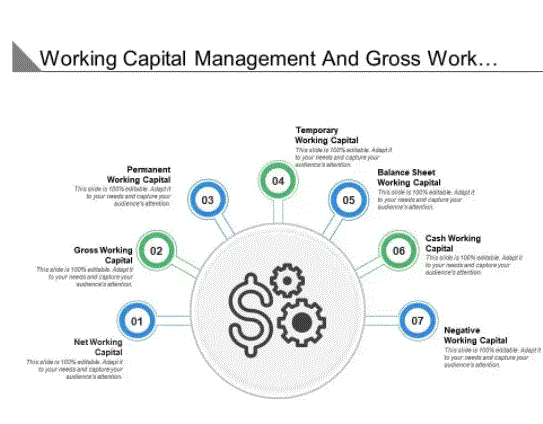
Working capital management is a business strategy designed to ensure that a company operates efficiently by monitoring and using its current assets and liabilities to their most effect use. The efficiency of working capital management can be quantified using ratio analysis.
- What Is Working Capital Management?
- Understanding Working Capital Management
- Why Manage Working Capital?
- Working Capital Management Ratios
- What Is Working Capital Management?
- Why The Three Ratios are important
- The Importance of Working Capital Management
- Factors That Affect Working Capital Needs
- Conclusion
- Working capital management is a business strategy designed to ensure that a company operates efficiently by monitoring its current assets and liabilities and for their most effective use.
- The efficiency of working capital management can be determined using ratio analysis.
- Working capital management requires monitoring a company’s assets and liabilities to maintain sufficient cash flow to meet its short-term operating costs and short-term debt obligations.
- Working capital management involves keeping track of various ratios including working capital ratio, collection ratio and inventory ratio.
- Working capital management can improve a company’s cash flow management and earnings quality by using its resources efficiently.
What Is Working Capital Management?

- The primary objective of working capital management is to enable the company to maintain sufficient cash flow to meet its short-term operating costs and short-term debt obligations. A company’s working capital is made up of its current assets minus its current liabilities.
- Current assets include anything that can be easily converted into cash within 12 months. These are the company’s highly liquid assets. Some current assets include cash, accounts receivable, inventory and short-term investments. Current liabilities are any liabilities that are payable within the following 12 months. These include operating expenses and accruals for the current portion of long-term loan payments.
Understanding Working Capital Management:
- Working capital management helps maintain the smooth operation of the net operating cycle, also known as the cash conversion cycle (CCC) – the minimum time required to convert net current assets and liabilities into cash.
- Working capital management can improve a company’s cash flow management and earnings quality through efficient use of its resources. Management of working capital includes managing inventory as well as managing accounts receivable and accounts payable.
- Working capital management also includes timing of accounts payable (i.e., suppliers making payments). A company may conserve cash to increase payments to suppliers and make the most of available credit or spend cash using cash – these choices also affect working capital management.
- The objectives of working capital management, in addition to ensuring that the company has sufficient cash to cover its expenses and debt, are to minimise the cost of funds spent on working capital and to maximise return on asset investment.
Why Manage Working Capital?
- The working capital ratio or current ratio is calculated as current assets divided by current liabilities. It is a key indicator of a company’s financial health as it reflects its ability to meet its short-term financial obligations.
- Although the numbers vary by industry, a working capital ratio below 1.0 usually indicates that a company is having trouble meeting its short-term obligations. That is, in the coming year, the company’s debt will not be compensated by its liquid assets. In this case, the company may have to resort to selling off assets, securing long-term debt, or using other financing options to cover its short-term debt obligations.
- A working capital ratio of 1.2 to 2.0 is considered desirable, but a ratio greater than 2.0 may suggest that the company is not using its assets effectively to increase revenue. A high ratio may indicate that the company is not managing its working capital efficiently.
- The collection ratio, also known as Days Sales Outstanding (DSO), is a measure of how efficiently a company manages its accounts receivable. The collection ratio is calculated as the product of the number of days in the accounting period multiplied by the average amount of accounts receivable divided by the total amount of net credit sales during the accounting period.
- The collection ratio calculation provides the average number of days it takes for a company to receive payment after a sales transaction on credit. If a company’s billing department is effective in its collection efforts and customers pay their bills on time, the collection ratio will be low. The lower the company’s collection ratio, the faster it will convert receivables into cash.
- Another important element of working capital management is inventory management. To operate with maximum efficiency and maintain a comfortably high level of working capital, a company must keep enough inventory on hand to meet customer needs, while avoiding unnecessary inventory that adds to working capital.
- Companies typically measure how efficiently that balance is maintained by monitoring the inventory turnover ratio. The inventory turnover ratio, calculated as cost of goods sold divided by average balance sheet inventory, tells how quickly a company’s inventory is being used and replaced in sales. A relatively low ratio compared to industry peers indicates a risk that inventory levels are excessively high, while a relatively high ratio may indicate insufficient inventory levels.
Working Capital Management Ratios:
The three important ratios in working capital management are the working capital ratio (or current ratio), the collection ratio, and the inventory turnover ratio.
Current Ratio (Working Capital Ratio):
Collection Ratio (Days Outstanding Sales)
Inventory Turnover Ratio

What Is Working Capital Management?
Working capital management aims to make more efficient use of a company’s resources by monitoring and optimising the use of current assets and liabilities. The goal is to maintain sufficient cash flow to meet its short-term operating costs and short-term debt obligations, and to maximise profitability. Working capital management is the key to the cash conversion cycle (CCC), or the amount of time a firm uses to convert working capital into usable cash.
Why The Three Ratios are important:
Why is the current ratio important?
The current ratio (also known as the working capital ratio) indicates how well a firm is able to meet its short-term obligations, and is a measure of liquidity. Companies with a current ratio of less than 1.00 mean that short-term debt and bills are higher than current assets, an indication that the company’s finances may be at risk in the short term.
Why is the collection ratio important?
The collection ratio, or days’ sales outstanding (DSO), is a measure of how efficiently a company can collect accounts receivable on its accounts. If it takes a long time to collect, it may be a sign that there won’t be enough cash to meet near-term obligations. Working capital management tries to improve the collection speed of receivables.
Why is Inventory Ratio Important?
The inventory turnover ratio shows how efficiently a company sells its stock. A relatively low ratio compared to industry peers indicates a risk that inventory levels are excessively high, while a relatively high ratio may indicate insufficient inventory levels.
- Proper management of working capital is essential to a company’s fundamental financial health and operational success as a business. A hallmark of good business management is the ability to use working capital management to strike a solid balance between growth, profitability and liquidity.
- A business uses working capital in its day-to-day operations; Working capital is the difference between a business’s current assets and current liabilities or debts. Working capital serves as a metric of how efficiently a company is operating and how financially stable it is in the short term. The working capital ratio, which divides current assets by current liabilities, indicates whether a company has enough cash flow to cover short-term debt and expenses.
- Efficient working capital management helps maintain smooth operations and can also help improve a company’s earnings and profitability. Management of working capital includes managing inventory and managing accounts receivable and accounts payable. The main objectives of working capital management include maintaining the operating cycle of working capital and ensuring its orderly operation, minimising the cost of capital spent on working capital and maximising the return on current asset investment.
- Working capital is an easily understood concept, as it is linked to an individual’s cost of living and can therefore be understood in a more personal manner. Individuals need to collect the money that is owed to them and maintain a fixed amount on a daily basis to cover day to day expenses, bills and other routine expenses.
- Working capital is a prevalent metric for a company’s efficiency, liquidity and overall health. It is a reflection of the results of various company activities, including revenue collection, debt management, inventory management and payments to suppliers. This is because it includes inventory, accounts payable and receivable, cash, portions of debt within a one-year period, and other short-term accounts.
- Working capital requirements vary from industry to industry, and they can vary even among similar companies. This is due to a number of factors, including differences in collection and payment policies, timing of asset purchases, the company’s likelihood of receivables of some of its past-due accounts, and in some instances, the capital-raising efforts a company is making.
- When a company does not have enough working capital to meet its obligations, financial insolvency can result and lead to legal trouble, liquidation of assets and potential bankruptcy.
- Working capital management is essentially an accounting strategy with a focus on the maintenance of an adequate balance between a company’s current assets and liabilities. An effective working capital management system helps businesses not only meet their financial obligations but also boost their earnings.
- Management of working capital means the management of inventory, cash, accounts payable and accounts receivable. An efficient working capital management system often uses key performance ratios, such as the working capital ratio, inventory turnover ratio and collection ratio, to help identify areas that need attention to maintain liquidity and profitability. it occurs.
The Importance of Working Capital Management:

Factors That Affect Working Capital Needs:
Working capital needs are not the same for every company. The factors affecting working capital needs can be endogenous or exogenous.
Endogenous factors include company size, structure and strategy.
Exogenous factors include the access and availability of banking services, the level of interest rates, the type of industry and products or services sold, macroeconomic conditions, and the size, number and strategy of the company’s competitors.
Liquidity management
Proper management of liquidity ensures that the company has sufficient cash resources for its normal business needs and unforeseen needs of a reasonable amount. It is also important because it affects a company’s goodwill, which can contribute to determining the success or failure of a business.
Accounts receivable management
A company must provide reasonable flexibility or level of commercial credit to its customers while ensuring that the right amount of cash flows through operations. A company will determine the credit terms to be offered based on the financial strength of the client, industry policies and the actual policies of competitors.
Management list
Inventory management aims to ensure that the company maintains a sufficient level of inventory to cope with normal operations and fluctuations in demand without investing a lot of capital in assets.
Short term debt management
Like liquidity management, management of short-term financing should also focus on ensuring that the company has sufficient liquidity to finance short-term operations without taking on excessive risk.
Accounts Payable Management
Accounts payable arises from trade credits granted by a company’s suppliers, mostly as part of normal operations. The right balance must be achieved between the initial payment and the commercial loan.
Advantages of Working Capital Management:
Businesses often run into trouble due to a lack of cash needed to operate and repay short-term debt. This happens due to ineffective or no working capital management policy in the enterprise. Working capital management ensures liquidity by monitoring accounts receivable, accounts payable, stock management and debt management. This helps the business have enough liquid cash at any given time to pay operating costs and short-term loans. Thus, it helps in allocating the resources in an optimal manner.

- Working capital management involves balancing balances relating to five main items cash, trade receivables, trade payables, short-term financing, and inventory to ensure that a business has sufficient resources to operate efficiently.
- The level of cash should be sufficient to meet normal or small unforeseen needs, but not so high to determine an inefficient allocation of capital. Commercial credit must be used appropriately to balance the need to maintain healthy business relationships with sales and the need to limit risk for customers with low creditworthiness.
- Management of short-term debt and accounts payable should allow the company to obtain sufficient liquidity for normal operations and unforeseen needs, without excessively increasing financial risk.
- Inventory management must ensure that it has enough products and materials to sell for its production processes, while avoiding excessive accumulation and obsolescence.
Conclusion:





